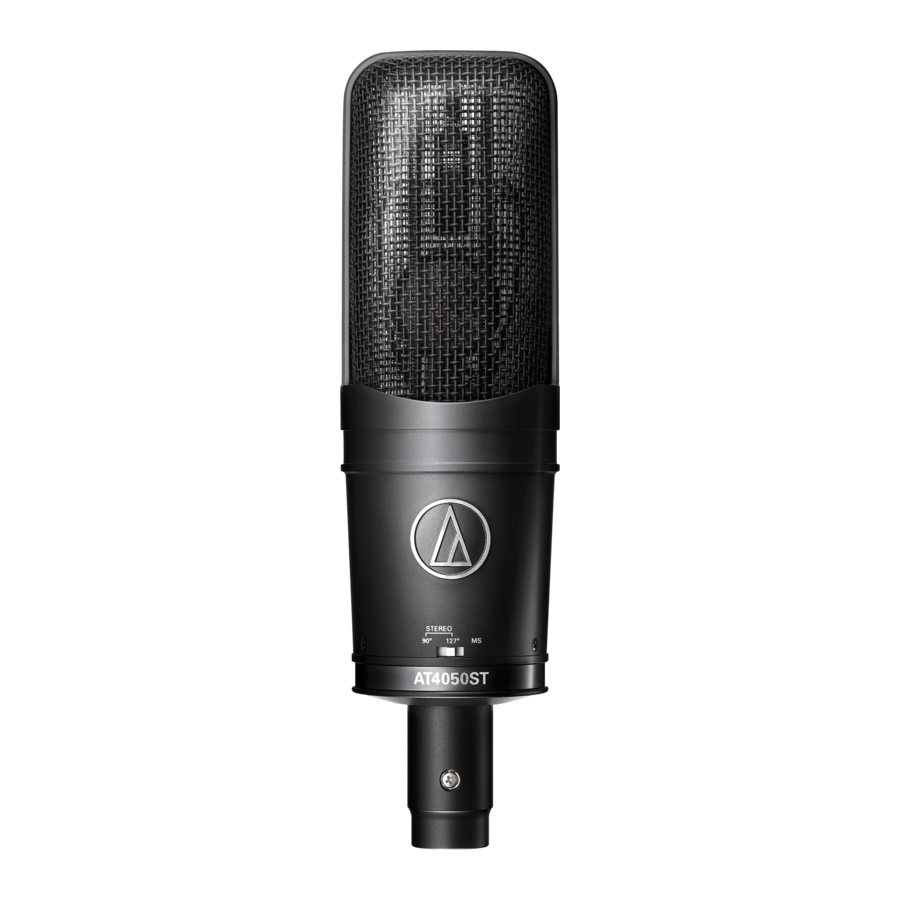
Advertisement

Features
Before using the product, read through the user manual to ensure that you will use the product correctly. Please keep this manual for future reference.
- Innovative side-address Mid-Side stereo microphone engineered for professional recording, broadcast and sound reinforcement
- Independent cardioid and figure-of-eight condenser elements
- Switch selection of M-S mode and two internally matrixed stereo modes
- Dual-diaphragm capsules maintain precise polar pattern definition across the full frequency range
- Transformerless circuitry virtually eliminates low-frequency distortion and provides superior correlation of high-speed transients
- The 2-micron-thick, vapor-deposited gold diaphragms undergo a fivestep aging process so that the optimum characteristics remain constant over years of use
- Open acoustical environment of the symmetrical housing assembly minimizes unwanted internal reflections
- Custom shock mount provides superior isolation
- Integral 80 Hz low-cut filter switch and 10 dB pad switch
- State-of-the-art design and manufacturing techniques ensure compliance with A-T's stringent consistency and reliability standards
Safety precaution
Although this product was designed to be used safely, failing to use it correctly may result in an accident. To ensure safety, observe all warnings and cautions while using the product.

- Do not subject the product to strong impact to avoid malfunction.
- Do not disassemble, modify or attempt to repair the product.
- Do not handle the product with wet hands to avoid electric shock or injury.
- Do not store the product under direct sunlight, near heating devices or in a hot, humid or dusty place.
Notes on use
- A raised Audio-Technica emblem is on the front of the microphone. Position this side of the microphone toward the sound source.
- Do not twirl or pull the microphone by the cable.
- Do not wrap the cable around the rack or an item of furniture, nor get the cable caught in it.
- In use, secure the cable to the microphone stand or boom, leaving a slack loop at the microphone. This will ensure the most effective shock isolation and reduce the possibility of accidentally pulling the microphone out of its mount.
Connection procedure
Connect the output terminals of the microphone to the 5-pin XLRF-type connector on the included cable. Connect the two 3-pin XLRM-type output connectors on the opposite end of the cable to devices that have a microphone input (balanced input) compatible with a phantom power supply.
The output connectors are XLRM-types with polarities as show in the figures below.



This product requires 48 V DC phantom power total for L ch and R ch.
Switch settings

To reduce the pickup of low-frequency ambient noise (such as traffic, air-handling systems, etc.), room reverberation and mechanically coupled vibrations, turn ON ( ) the low-cut filter switch located on the side of the product.
) the low-cut filter switch located on the side of the product.
When audio input exceeds the maximum input sound level, set the pad switch to -10 dB.
Mode Setting

Mid-Side Operation: In M-S mode, the microphone provides independent Mid and Side signals. This allows the width of the stereo image to be adjusted in post production or in the field with a matrix mixer.
Matrixed Stereo: The microphone offers two internally matrixed modes which provide traditional "left-right" stereo without the need for external mixers. To accommodate varying acoustic environments, the user may select between a wide pattern (127°) with increased ambient pickup, and a narrow pattern (90°) which offers more rejection and less ambience.
| 90° | Stereo mode (LR narrow) is set. |
| 127° | Stereo mode (LR wide) is set. |
| MS | MS direct mode is set. |
Specifications
| Elements | Externally-polarized (DC bias) condenser |
| Polar patterns | Cardioid, Figure-of-eight |
| Frequency response | 20-18,000 Hz |
| Low cut | 80 Hz, 12 dB/octave |
| Pad | -10 dB |
| Open circuit sensitivity |
Stereo 90º: -42 dB (7.9 mV) Stereo 127º: -41 dB (8.9 mV) Mid: -36 dB (15.8 mV) Side: -36 dB (15.8 mV) (0 dB = 1 V/Pa, 1 kHz) |
| Impedance | 50 ohms |
|
Maximum input sound level (Mid and Side) |
149 dB SPL (1 kHz at 1% THD) 159 dB SPL (When pad is on.) |
| Noise |
Stereo 90º: 25 dB SPL Stereo 127º: 16 dB SPL Mid: 15 dB SPL Side: 17 dB SPL (A-weighted) |
| Dynamic range |
Mid: 134 dB Side: 132 dB (1 kHz at Max SPL) |
| Signal-to-noise ratio |
Stereo 90º: 69 dB Stereo 127º: 78 dB Mid: 79 dB Side: 77 dB (1 kHz at 1 Pa, A-weighted) |
| Phantom power requirements | 48V DC, 6.4 mA (both channels total) |
| Switches | Stereo mode selection (90°, 127°, MS), Low cut: on/off, Pad: on/off |
| Weight | 517 g (18.2 oz) |
| Dimensions |
193.0 mm (7.60") long, 53.4 mm (2.10") maximum body diameter |
| Output connector | Integral 5-pin XLR-M type |
| Cable | 5.0 m (16.5') long, 5-pin XLR-F type connector at microphone end and two 3-pin XLR-M type connectors at output end |
| Audio-Technica case style | R1 |
| Included accessories | AT8449a shock mount, stand adapter(3/8"-5/8"), microphone dust cover, 5.0 m (16'5") cable, carry case |
- 1 Pascal = 10 dynes/cm2 = 10 microbars = 94 dB SPL
For product improvement, the product is subject to modification without notice.
Polar pattern
Mid polar pattern

Side polar pattern

127° polar pattern

90° polar pattern

LEGEND

SCALE IS 5 DECIBELS PER DIVISION
Frequency response

LEGEND
 |
0°, 50 cm |  |
0°, 50 cm, Low cut |
Dimensions

Unit
Included accessories


Documents / ResourcesDownload manual
Here you can download full pdf version of manual, it may contain additional safety instructions, warranty information, FCC rules, etc.
Advertisement
Thank you! Your question has been received!













Need Assistance?
Do you have a question about the AT4050ST that isn't answered in the manual? Leave your question here.